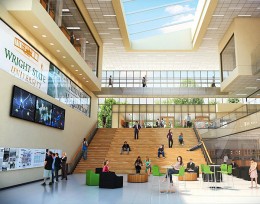The Wright State University College of Engineering and Computer Science marked its 25th anniversary on Friday, May 11, by announcing a new assistantship program that will provide scholarships, internships and a path to employment for 30 undergraduate students.
The announcement was a key part of an afternoon celebration that included student project demonstrations, laboratory tours, recognition of donors and a peek at the college’s future.
President David R. Hopkins congratulated the college’s faculty for producing successful graduates but also praised them for partnering with business and industry to improve the region’s economy, for making Wright State one of Ohio’s leading research institutions, and for engaging students in the community to help solve community problems.
“What you’ve accomplished in 25 years is truly remarkable,” said Hopkins, who delivered his remarks in a video because he was traveling.
Congressman Steve Austria praised the partnership between the college and Wright-Patterson Air Force Base. “Wright State University is an important leg in the region’s defense sector,” he said.
S. Narayanan, Ph.D., Dean of the College of Engineering and Computer Science, underscored that relationship in announcing a new partnership between the college and the Air Force Research Laboratory (AFRL).
The Dean’s AFRL-Discovery Lab Industry Experiential Learning Assistantship will provide 30 students with renewable scholarships of $6,000 per academic year and $4,000 yearly research assistantships with AFRL’s Year at the Edge (YATE) Program.
The assistantship is for three years—a minimum of two years with AFRL, and the third with an industry partner. Each student will then be eligible for an internship in his or her senior year with the sponsoring industrial partner, positioning the student for a full-time position upon graduation.
“The whole model is geared so the students can graduate debt-free,” Narayanan said.
State Sen. Chris Widener said Wright State “and particularly this college” have been helping Ohio rebuild the state’s work force. “An educated work force is the only way we can create jobs,” he said.
The college’s capacity to produce quality graduates has grown dramatically over the years. Krishan Joshi, who with his wife Vicky were the major donors for the Joshi Research Center, noted the Wright State campus consisted of just three buildings when he taught mathematics here in the early 1970s.
“In a few years we will have three buildings just for this college,” he said.
In addition to the Russ Engineering Center and the Joshi Research Center, Wright State will soon add the Neuroscience and Engineering Collaboration building. To be located between the Russ Engineering Center and the Boonshoft School of Medicine, the $37 million facility will house 125 people, including researchers in the $22 million neuroscience research center the university is creating in partnership with Premier Health Partners.
Narayanan showed an artist’s renderings of the building and said the facility will foster collaboration among scientists, clinical researchers and engineers to bridge the gap between basic science and commercial products for better health care as well as economic growth.
“We are poised for a great future,” he said.


 Wright State Police Department delivers major donation to Raider Food Pantry
Wright State Police Department delivers major donation to Raider Food Pantry  Wright State engineering and computer science students earn prestigious federal SMART Scholarships
Wright State engineering and computer science students earn prestigious federal SMART Scholarships  Wright State Police Chief Kurt Holden selected for prestigious FBI National Academy program
Wright State Police Chief Kurt Holden selected for prestigious FBI National Academy program  Wright State’s Raj Soin College of Business ranked among the best for entrepreneurs by Princeton Review
Wright State’s Raj Soin College of Business ranked among the best for entrepreneurs by Princeton Review  Wright State’s annual Raidersgiving draws hundreds
Wright State’s annual Raidersgiving draws hundreds 